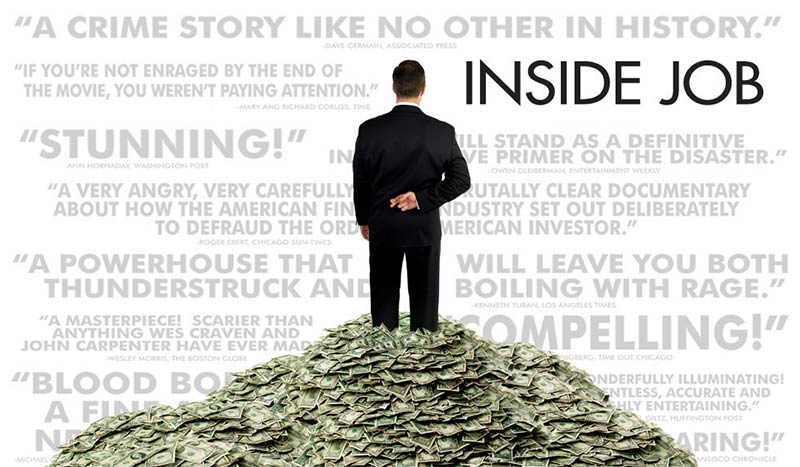Director: Charles Ferguson,
Watched on: DVD,
Rating: 5/5.
It is very provincial of me to say this, but Seattle may be one of the few cities in the country where audiences still applaud at the end of a film they enjoyed, and it is probably the only city where an audience will applaud at the end of a documentary. But Inside Job is that kind of film. The movie is a clear, detailed and thorough examination of the head-in-the-sand politics and back room criminal activity that created the financial mess of 2008. The film was produced, written and directed by Charles Ferguson, the same filmmaker who investigated the folly that was the run up to the Iraq debacle. That film’s title alone, No End In Sight, was not only prescient but could also serve as the title for this film as well. In both cases, there seems to be no way out of either the Iraq war or the so-called Great Recession, which has clamped itself on the American public like a set of manacles that may never be removed.
Of course, we’re talking about the Great Recession that affects 98% of Americans; not the richest 2% who continue to make bundles of money in executive bonuses and use it to bribe politicians into passing ineffective financial reform and lobbying for tax cuts for themselves and their richest friends. Inside Job will not only enrage you, it will depress you. That may not sound like a great time at the movies, but if you want to finally understand the backroom politics of deregulation and criminal complicity that allowed greed to take over America, leading to the mess we’re in now, a mess that many financial experts predicted a decade ago, than this is your film.
Director Ferguson’s movie moves quickly. His long list of talking head interviews is supported with easy-to-understand animated graphics, clips of C-Span House and Senate hearings, and a concise narrative track delivered by Matt Damon. We start at the beginning, with Ronald Reagan’s scorched earth campaign of financial deregulation making millionaires out of politicians, lobbyists and middle management suck-ups. The same people who were eventually put in charge of policing the financial industry were getting rich off it. As the film moves through the ‘90s and into the 2000s, as easy-to-get mortgages became the norm for Americans, as we all accumulated the kind of debt that would have scared the pants off our greatest generation parents, Wall Street became one big money laundering operation. Investments that should have been high-risk were certified as no-risk, the supposedly independent investment rating firms were hired by banks to rate their bad bets as safe bets, economics experts at major universities were paid to write favorable evaluations of a system trading junk, and a black hole stuffed with Americans’ hard-earned paychecks eventually ends up in the pockets of a few thousand already obese fat cats.
Call it what you will—a house of cards or a Ponzi scheme—but there is little doubt among the many insider experts Ferguson interviews that Wall Street was doomed to collapse. There is also little accountability among the insiders who declined to be interviewed for the film, including Timothy Geithner, Ben Bernanke, Hank Paulsen and Larry Summers, all of whom were tapped by our new president to clean up the mess. It is perhaps the most depressing moment in the film when you realize that yes, it really is true, Obama invited the foxes to clean up the hen house.
Ferguson’s outrage is palpable. He asks jabbing questions from behind the camera and causes several so-called financial wizards to squirm and stumble on camera; he visits a Florida tent city populated by foreclosed homeowners; and he ends the film on a soaring shot of the Statue of Liberty, asking a question that is less of a call to action and more of a “what do we now?” The answer is another question: “what can we do?” when the people elected to lead us are the very people robbing us blind.

